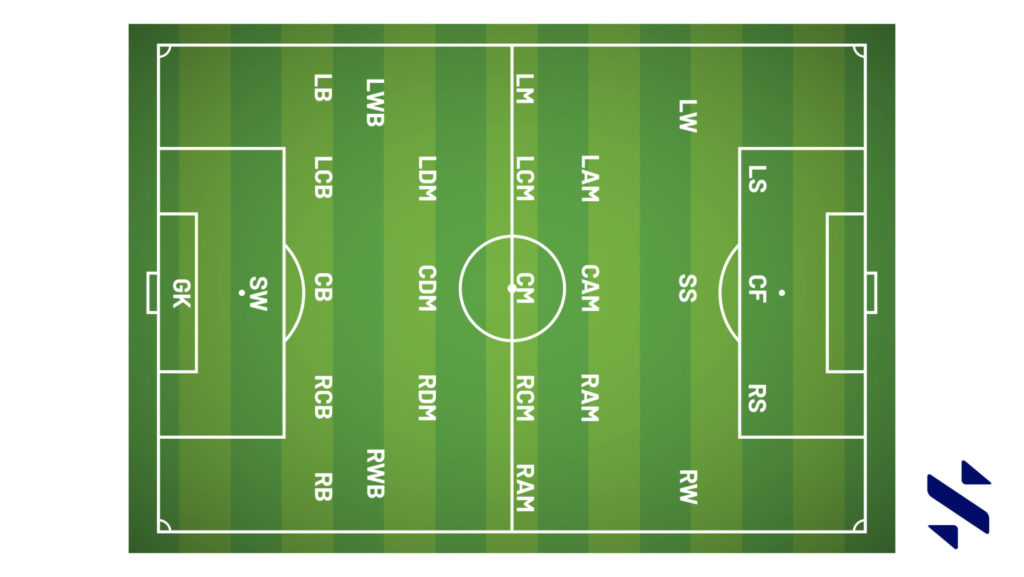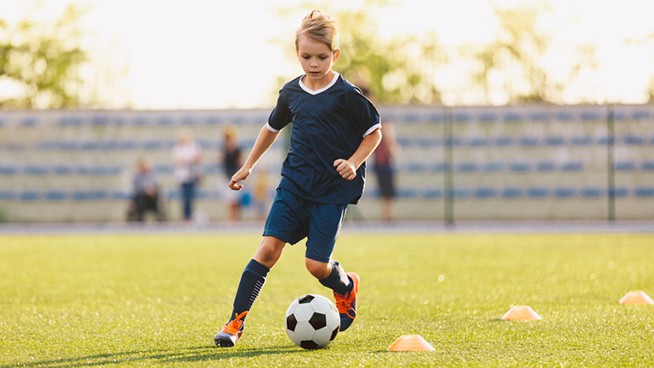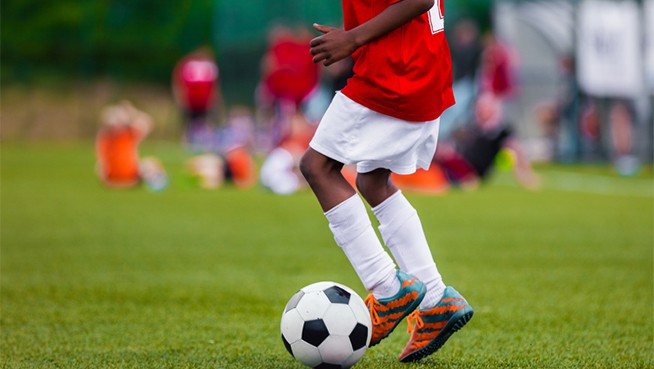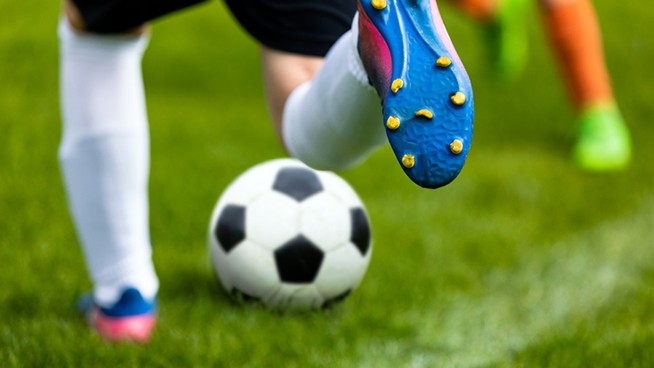The Soccer Positions: Explained
Soccer is an invasion-type game where 11 players on each team try to put the ball in the opponent’s goal. Players have to control the ball with their feet, hence why the game is called football everywhere in the world except North America. Players are allowed to move anywhere on the pitch at any time and switch from defense to attack frequently. As players and teams develop, they start to specialize in different positions and patrol certain areas of the pitch. Most players learn different positions except for goalkeepers until they settle into one or two specific roles. Understanding the different positions and what they do helps players at all levels. Players have to be flexible to adjust to the coach’s tactics and to what the opposition are doing. Here is a brief summary of the normal positions.
Playing Zones
A full-size soccer pitch is 105 meters long and 68 meters wide. Although there is a line dividing the pitch at halfway, there is no restrictions on where players can go, except for the offside rule (attackers can’t loiter around the opponent’s goal behind defenders. Every attack must start from in front of the defenders).
However, it is useful to think of the pitch as divided into three zones: the defending zone, the midfield zone and the attacking zone. Soccer is a possession game: you can’t win without the ball.
- When the ball is in the defending zone, defenders must maintain possession or try to take the ball from the opposition.
- In the midfield zone, players pass the ball and try to move into the opponent’s half. They look for opportunities to pass to attackers in the attacking zone or prevent opponents from making attacks.
- In the attacking zone, more risks are taken and possession of the ball may be lost. Midfielders look to pass the ball into spaces behind the defenders so that the attackers can run to the ball and try to score a goal. They can do this with feet or head.
The Defenders
- The goalkeeper: The last line of defense and the only player who can use their hands to catch and pass the ball (except throw-ins). They stay in goal and have to be agile. They are usually taller with longer arms as the goal is a big area to defend. They catch or punch the ball to deflect it away from the goal. They can kick it or throw it to their teammates to start a counterattack.
- Full back: two players, one left and one right whose job is to mark the opponent’s wingers. They look to link the ball between the goalkeeper and the midfielder in front of them. They often take throw-ins, allowing more players to get in front of the ball.
- Center-back: Either one or two players (depending on the formation) who are physically strong and tall. This allows them to head the ball away from the goal. They man-mark the opposition. They have to have accurate, long passes. They often move up into the opponent’s goal area when there are set-piece attacking positions like a corner or free-kick: their height gives a target for heading the ball into the net.
- Wing-back: a more modern version of the full-back. They still mark the opponent’s wingers but they also move up and down the touchline and cross the ball into the midfield. They have to be very fit as they run a lot.
The Midfielders
There are a lot of different playing formations and each team plays differently. Some play with 3 midfielders, others with 4 or even 5. Coaches talk about shapes: diamonds, lines, triangles. The mid-fielders rarely stand or play in a straight line. Instead, they are looking to connect to each other with short passes and runs onto the ball.
- Winger: Stands wide on the touchline and crosses the ball into the goal area. A very fast player who tries to get past defenders before making a crucial pass.
- Defending Mid-fielder: Stands just in front of the defensive line and links between defenders and the other mid-fielders. They can either be a stalwart in defence who stops the opponents attackers, a tenacious attacker, or they can be a playmaker with good vision who looks to distribute the ball like a quarterback to other players.
- Center-midfielders: Players with good ball skills and great vision. They have to create attacks and run back to defend. They must be able to pass well with both feet. Good players pass and then sprint to support the attack, so the speed of thought and speed of movement are essential. They must be able to communicate well.
- Attacking Midfielder: A creative player with good vision who can see where spaces are for attackers to run into. The ability to shoot from a long way out takes strength and technique and develops over time. Again,
The Attackers
Again, different coaches play different formations. There may be 2 or 3 attackers in a team. Sometimes the two attackers line up parallel to each other sometimes one sits in front of the other. Speed, confidence and the ability to shoot on target are essential qualities in all attackers.
Remember that any player can shoot at the goal: midfielders and wingers can also overlap and come in to shoot.
- Forward: The player who sits behind the striker. Has great vision and the ability to create opportunities to score for himself or the striker. They often seem to roam around the attacking area looking for space and opportunities before moving decisively into position.
- Striker: The goalscorer and target for passes from his teammates. He sits closest to the opponent’s goal and hassles the defenders when they are in possession. He must also hold onto the ball and pass to a supporting player if he is prevented from turning and shooting. Has to be fast and able to shoot with both feet and head the ball in.
Summary
This was a brief overview of the main positions. Remember that each team is slightly different and coaches adapt to the available players. Playing in different positions helps developing players understand the whole game. Every player needs to tackle, pass and communicate with their teammates.
RECOMMENDED FOR YOU
MOST POPULAR
The Soccer Positions: Explained
Soccer is an invasion-type game where 11 players on each team try to put the ball in the opponent’s goal. Players have to control the ball with their feet, hence why the game is called football everywhere in the world except North America. Players are allowed to move anywhere on the pitch at any time and switch from defense to attack frequently. As players and teams develop, they start to specialize in different positions and patrol certain areas of the pitch. Most players learn different positions except for goalkeepers until they settle into one or two specific roles. Understanding the different positions and what they do helps players at all levels. Players have to be flexible to adjust to the coach’s tactics and to what the opposition are doing. Here is a brief summary of the normal positions.
Playing Zones
A full-size soccer pitch is 105 meters long and 68 meters wide. Although there is a line dividing the pitch at halfway, there is no restrictions on where players can go, except for the offside rule (attackers can’t loiter around the opponent’s goal behind defenders. Every attack must start from in front of the defenders).
However, it is useful to think of the pitch as divided into three zones: the defending zone, the midfield zone and the attacking zone. Soccer is a possession game: you can’t win without the ball.
- When the ball is in the defending zone, defenders must maintain possession or try to take the ball from the opposition.
- In the midfield zone, players pass the ball and try to move into the opponent’s half. They look for opportunities to pass to attackers in the attacking zone or prevent opponents from making attacks.
- In the attacking zone, more risks are taken and possession of the ball may be lost. Midfielders look to pass the ball into spaces behind the defenders so that the attackers can run to the ball and try to score a goal. They can do this with feet or head.
The Defenders
- The goalkeeper: The last line of defense and the only player who can use their hands to catch and pass the ball (except throw-ins). They stay in goal and have to be agile. They are usually taller with longer arms as the goal is a big area to defend. They catch or punch the ball to deflect it away from the goal. They can kick it or throw it to their teammates to start a counterattack.
- Full back: two players, one left and one right whose job is to mark the opponent’s wingers. They look to link the ball between the goalkeeper and the midfielder in front of them. They often take throw-ins, allowing more players to get in front of the ball.
- Center-back: Either one or two players (depending on the formation) who are physically strong and tall. This allows them to head the ball away from the goal. They man-mark the opposition. They have to have accurate, long passes. They often move up into the opponent’s goal area when there are set-piece attacking positions like a corner or free-kick: their height gives a target for heading the ball into the net.
- Wing-back: a more modern version of the full-back. They still mark the opponent’s wingers but they also move up and down the touchline and cross the ball into the midfield. They have to be very fit as they run a lot.
The Midfielders
There are a lot of different playing formations and each team plays differently. Some play with 3 midfielders, others with 4 or even 5. Coaches talk about shapes: diamonds, lines, triangles. The mid-fielders rarely stand or play in a straight line. Instead, they are looking to connect to each other with short passes and runs onto the ball.
- Winger: Stands wide on the touchline and crosses the ball into the goal area. A very fast player who tries to get past defenders before making a crucial pass.
- Defending Mid-fielder: Stands just in front of the defensive line and links between defenders and the other mid-fielders. They can either be a stalwart in defence who stops the opponents attackers, a tenacious attacker, or they can be a playmaker with good vision who looks to distribute the ball like a quarterback to other players.
- Center-midfielders: Players with good ball skills and great vision. They have to create attacks and run back to defend. They must be able to pass well with both feet. Good players pass and then sprint to support the attack, so the speed of thought and speed of movement are essential. They must be able to communicate well.
- Attacking Midfielder: A creative player with good vision who can see where spaces are for attackers to run into. The ability to shoot from a long way out takes strength and technique and develops over time. Again,
The Attackers
Again, different coaches play different formations. There may be 2 or 3 attackers in a team. Sometimes the two attackers line up parallel to each other sometimes one sits in front of the other. Speed, confidence and the ability to shoot on target are essential qualities in all attackers.
Remember that any player can shoot at the goal: midfielders and wingers can also overlap and come in to shoot.
- Forward: The player who sits behind the striker. Has great vision and the ability to create opportunities to score for himself or the striker. They often seem to roam around the attacking area looking for space and opportunities before moving decisively into position.
- Striker: The goalscorer and target for passes from his teammates. He sits closest to the opponent’s goal and hassles the defenders when they are in possession. He must also hold onto the ball and pass to a supporting player if he is prevented from turning and shooting. Has to be fast and able to shoot with both feet and head the ball in.
Summary
This was a brief overview of the main positions. Remember that each team is slightly different and coaches adapt to the available players. Playing in different positions helps developing players understand the whole game. Every player needs to tackle, pass and communicate with their teammates.












